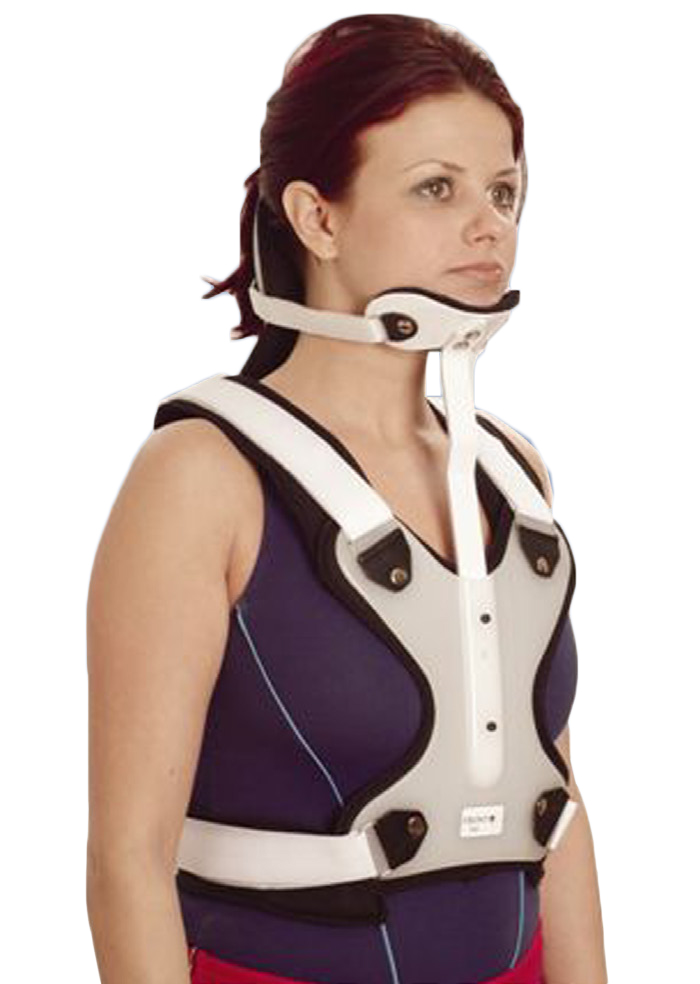Minerva Brace – A Guide for Patients
INTRODUCTION |
||
| You have been fitted with a Minerva brace to stabilise a fracture or dislocation of the bones in your upper (cervical) spine. It may also be fitted following surgery in this area.
This brace is designed to immobilise your spine to permit the ligaments and bones to heal, which normally takes between 6-12 weeks. Once a satisfactory position is obtained, you will be able to start sitting up and getting out of bed. Once you are moving around freely, you may be discharged home or to a rehabilitation facility. Regular visits to the hospital are required for showers and reviews by your specialist. The Minerva brace is generally worn 24 hours per day and is not removed under any circumstances unless by your Orthotist or Specialist. Initially, your Minerva brace may feel awkward. You will soon learn the most comfortable position for sitting, lying and moving. |
 |
Activity
It is important for your physical and mental well being that you are as active as possible. The amount of activity you should undertake should be discussed with your specialist but you should avoid any heavy lifting, running or activities involving heavy physical contact.
If you are attending school or have a job which does not require physical activity or lifting you may be able to return to these activities.
If, during activity you experience any aching or pain in your neck, you should stop and rest. This is more common in the earlier stages of wearing a Minerva. If pain persists or you have a change in the feeling or strength in any of your limbs contact your specialist immediately.
Sleep
Initially you may have difficulty sleeping until you find a comfortable position. You should sleep on your back or side.
You may use a small pillow or folded towel to support your head (about 2 inches thick).
Sitting Up & Getting Out of Bed
If you have a reclining bed, do not let anyone wind you up whilst lying on the mattress. You should sit up and then have the backrest brought up to your level.
The same should be done if wanting to lie back down from a sitting position. This will prevent movement of the brace and any undue stress being placed on your spine.
When getting out of bed, do not sit up from a lying position as this places stress on your cervical spine. Instead, roll onto your side and push up whilst slipping your legs over the side of the bed.
Ask your Physiotherapist or Orthotist to instruct you on how to do this.
Clothing
We ask that you do not wear anything under your brace. Most people have success wearing button up shirts and oversized jumpers which can easily be put on over the brace.
Ladies may wear bras or elasticised halter tops over the brace. These may need to be a larger size than they would normally wear so that they can fasten over the vest.
Sensible shoes with low heels and non-slip soles should be worn for safety. Sneakers are a good option because they are comfortable and practical. Uneven ground and slippery surfaces should be avoided, as the risk of falling is too great.
Travel
Your travel does not have to be restricted. You should be aware that in the early stages your endurance will be limited. You should plan your trips carefully, allowing some time for rests.
Under no circumstances should you drive a car whilst wearing a Minerva brace.
Bathing & Skin Care
A showering regime will be established for you prior to discharge. You will need to attend regular appointments with your Orthotist for showers and liner changes.
You must also remember to bring toiletries (soap, shampoo and towel) and your spare liners to these appointments.
If you do not have spare liners, please contact your orthotist before this appointment.
Between these appointments you are able to wash the areas of your body that are not covered by the brace. This is normally done by sponging or alternatively running a shallow bath and sitting in it to wash the lower half of your body. When doing this you may need to protect your vest with plastic bags to prevent it from getting wet.
Whilst wearing a Minerva brace we suggest that you cease shaving because pressure from the chin piece can result in ingrown hairs and skin irritation. If shaving is essential then you should discuss this with your orthotist.
Your skin will be checked whenever you have a shower and liner change. If you experience discomfort especially around the edge of the vest or over bony areas contact your Orthotist immediately.
Try and keep your skin as clean and dry as possible. Avoid using lotions and powders around the vest as these can cause skin irritations.
Eating
Once the Minerva brace is fitted, you should still be able to swallow, breathe and talk. It is normal to feel a force beneath your chin. Try to avoid pulling down on the chin piece as this can flatten it out and increase the pressure in this area.
The force under the chin is necessary to stabilise the spine, and it may make it difficult to open your mouth wide. Therefore, it is important to have your food cut into smaller pieces. Keep this in mind because it may take you longer to eat a meal than normal.
REMOVAL
You will attend regular appointments with your specialist. They will monitor your progress and inform you when the brace may be removed.
At this stage, you may be fitted with a collar to support your neck. At first your head may feel heavy and awkward whilst it gets used to supporting its own weight again.
Please remember that you must not remove your brace at any time, and do not try to adjust or modify the brace yourself.
If you have any problems or queries, please contact your Orthotist.